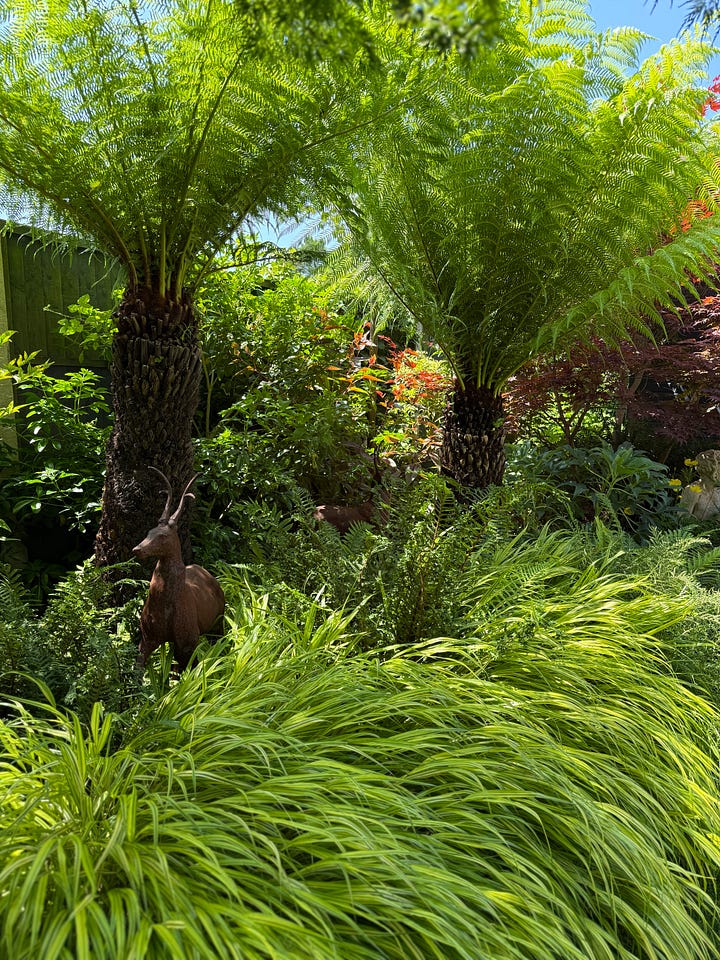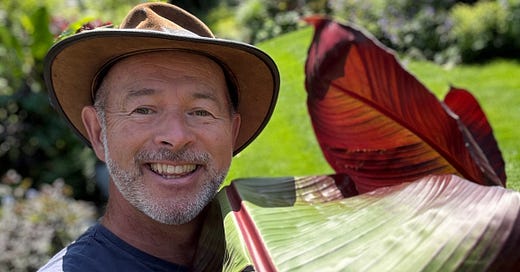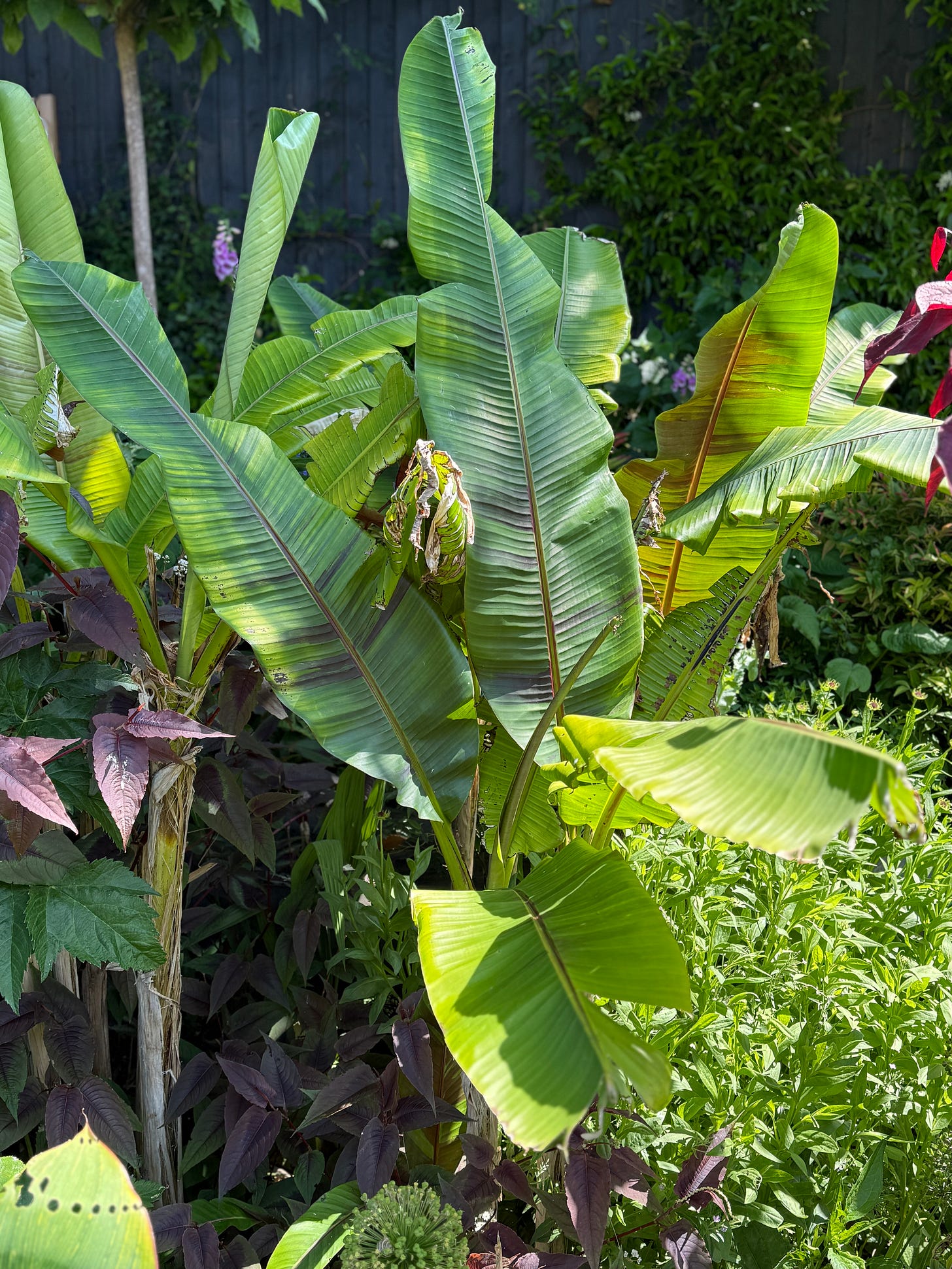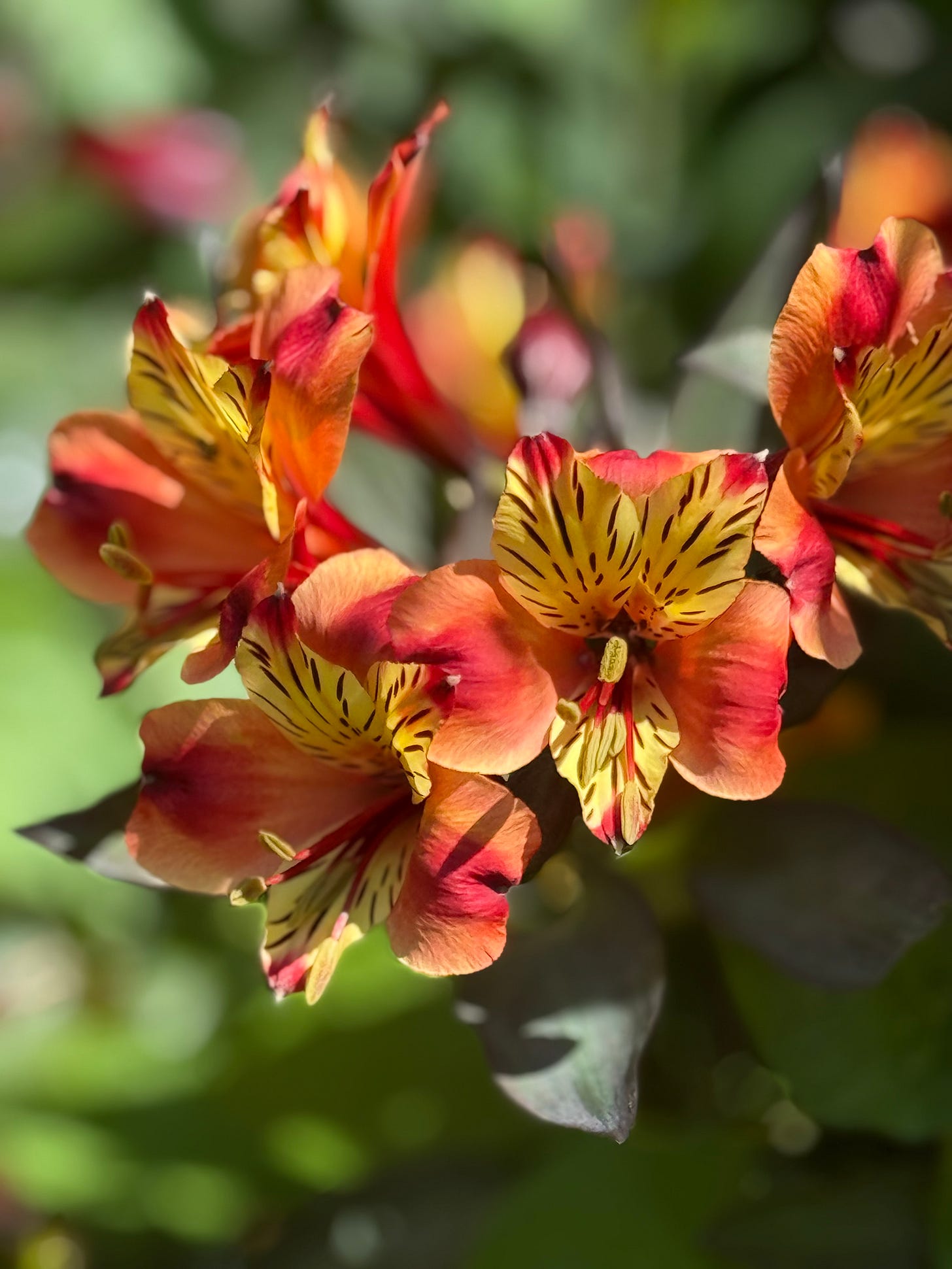Audio version (above)
I’ve been extremely lucky in my three score years, plus a handful of months… oh, go on then, and a few more, to have visited a number of ‘exotic’ destinations, including the breath-taking Maldives, searing hot, dusty, Kenya, Mauritius, and many of the stunning, Caribbean islands. These sun-drenched ports of call, palms swaying majestically over the gently lapping crystal-clear waters onto silver-sanded beaches evoke wonderful memories of lush, exotic plantings; fantastic foliage; towering, tropical trees, and striking orange, red and yellow blooms.
For all of us, holidays abroad can hold very special memories. And, as gardeners, many of us will come home, laden with duty-free tat, to find our tropical gardening dreams and inspiration shattered as we step off the plane, reaching for a brolly and a warm coat - the great British weather reminding us we’re back! But, fear not, despite the UK’s sometimes inclement weather, our exotic, horticultural dreams can still become a reality. Admittedly, and in the spirit of full disclosure, it’s unlikely we’ll be harvesting ripe bananas or mangoes from our gardens, nor picking heliconia (lobster claws) or orchids from our borders; although, with ever-changing weather patterns, who knows what the future holds. But you’ll be pleased to know, you can still get the exotic look by choosing trees, shrubs, perennials and annuals that will thrive in our gardens, some year-round, and others with a little protection. As always, my favourite mantra, right plant, right place is vitally important, so do check your soil and light conditions before you ‘jet-off’ to the garden centre.
Shady jungle-type plantings:
Height and structure offer an important, dramatic dimension to any garden, irrespective of its location or size, providing privacy and shelter, to us, and the wildlife that lives alongside us in our gardens, but also serving as a beneficial and protective microclimate to the other plants in the area.
In a cool, shady border in my garden, I have four stunning tree ferns, Dicksonia antarctica, that sit beneath the shade of a boundary wall and taller trees in a neighbouring garden. Each ‘prehistoric’, filigree-like frond can stretch up to 2m across (that’s 6ft in ‘old money’), casting dappled shade upon a swathe of hardy ferns beneath, including the stunning, spring-coloured, orange fronds of the Rosy Buckler fern, Dryopteris erythrosora, soft shield fern, Polystichum setiferum and the contrasting, smooth, glossy foliage of Asplenium scolopendrium, the Hart’s Tongue fern.
A host of cream variegated with blue or green hostas make great bedfellows for ferns, with Hosta ‘Big Daddy’ proving to be the hosta equivalent of Tyrannosaurus Rex, living up to its name, with oversized, seer-sucker-type, grey-blue leaves. Hosta flowers will provide subtle shades of purple and white with their small, bell-shaped flowers atop tall, elongated stems. Add an additional splash of colour with trailing begonias, which will tolerate some dappled shade. I plant up tall pots of Begonia boliviensis ‘Santa Cruz’ with its large, arrow-shaped leaves and tropical, fiery, blood-orange blooms, which I nestle into the border amongst the ferns. This dramatic, jungle-like planting is reminiscent of the backdrop for the blockbuster film, Jurassic Park, but I fear the only dinosaur on set is me!


Other shade-loving, hardy exotics include the giant, hand-like foliaged, Fatsia japonica, with the delicately variegated variety, ‘Spider’s Web’ a firm favourite of mine, lighting up a shady corner with its white, spider-web tracery.
Sunny sizzlers:
Tall and imposing, Cordyline australis, the Torbay Palm, provides height, structure and more than a hint of far-flung, exotic holidays. Thriving in mild locations, including coastal and urban gardens, they do require some protection in areas prone to frost. Their sword-like foliage comes in shades of green, purple and bronze, some edged with yellow, pink or white striped margins. Just one of these magnificent beauties planted in the garden gives an immediate feel of the tropics. Set temperatures soaring higher by underplanting with phormiums, with their leathery, strap-like leaves complementing the cordyline foliage perfectly. Some of my favourite phormiums include burgundy and pink edged, ‘Sundowner’; dramatic, almost black, ‘Platt’s Black’ and the pinky-orange, green edged ‘Jester’, but be inspired by your preferred colour choices.
Hardy bananas plants with their striking, paddle-like foliage, originate from subtropical, southern China and are, for me, the ultimate in turning our borders into totally tropical wonderlands. As the title suggests, they’re hardy, to approximately -10° C. Towering, Musa basjoo can reach 5m (16ft) in the right conditions, but I prefer the slightly smaller, Musa sikkimensis ‘Red Tiger’, reaching 4m (13ft) here with its regal, 2m (6ft) or longer, dark green leaves, streaked with random, dark maroon stripes on the underside. Keep an eye on winter weather and provide protection should temperatures start to plummet.
Supplement this sultry planting with canna lilies, their sumptuous and sizeable foliage coming in shades of green; dark purple, almost black and striking, zingy, tiger-striped patterns. Flamboyant Canna ‘Pretoria’ with its stripy, green and yellow foliage, followed by eye-searing, orange blooms, looks great planted alongside swathes of orange and yellow flowered heleniums and rudbeckias. The addition of appropriately named Alstromeria ‘Indian Summer’ in this hot themed mix with its bronze-flushed foliage and contrasting mango, lemon and raspberry cocktail blooms will transport you to a tropical, silver-sanded beach oasis before you know it.
Other stunning, exotic focal plants include Melianthis major, Phoenix canariensis, and Yucca rostrata ‘Blue Swan’.
Exotic container inspiration:
Capture a corner of the Caribbean with a container crammed with lush foliage and cooling, tropical blooms. You’ll need a large container (approximately 40cm x 40cm or 15x15in) and some peat-free, multi-purpose compost.
Colocasia esculenta, also known as Elephant Ears, is a striking houseplant which can be taken outside once the danger of frosts has passed, to take pride of place in a shady corner. Add a touch of cool, contemporary class by underplanting it with the vibrant, clashing blooms of bedding impatiens (Impatiens walleriana).
Alternatively, plant the sultry, dark-red foliaged Ricinus communis (Castor oil plant) alongside pot marigolds for a touch of the tropics. Be mindful that all part of Ricinus communis are poisonous so position carefully around young ones and pets!
For a sizzling, sunny combination, in a taller container, the handsome, Abyssinian banana, Ensete ventricosum ‘Maurelii’ will have you reaching for a glass of something chilled when teamed with the retina-searing, frilly blooms of Pot Marigolds (Calendula officinalis). The Abyssinian banana is tender and will need some winter protection but could be substituted with an impressive canna, which are overwintered just like dahlia tubers.
So, why not bring a taste of the totally tropical to your garden this summer?
Thanks for reading and if you enjoyed this piece, make on old-guy really happy and give that old heart icon a tap for me!











Oh yes Mike - loved this one!
Of course, you'd know how I always go for tropicals! Like so many palms are. And I loved all the plants you mentioned with striking colors amidst the green. There's one palm like that - Lipstick Palm - Cyrtostachys renda which would not fly in GB, or even where I live. But I think it's gorgeous. When you see it, the common name becomes obvious.
I was surprised you mentioned Phoenix canariensis. A tall stately palm with a bushy round crown. It's considered good to go from USDA zones 9-11 (we've got them all around town - love their looks when well cared for), even 8b for arid areas - do you know how that's equivalent in GB?
In your gardening travels I think you probably have seen the Windmill palm - Trachycarpus fortunei. I've seen them all around surprising places, of course in GB, Ireland & most surprisingly Vancouver Canada.
I loved seeing the Cordyline australis, one of those called a palm, but it's not. It's in the asparagus family. But calling it a palm makes it fun! A friend of mine in New Zealand has one on her property.
So yes, I always love your writing, but this one was special for me, involving tropicals that are flexible! 👍☺️
And I was so happy I could bring a quite large Cornus cuosa Milky Way with me from Ireland. No branches broken in the suitcase
Now a Ceanothus which I bought in Italy 9 years ago is flowering but it is in a container and overwintering frost free during winter